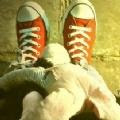


" Banker White was part of San Francisco's Recycling and Disposal Artist in Residence program, and during residency, collected enough Coke bottle labels to create this Afghan prayer rug entitled "Give the Magic." The artist had the interesting idea to "[use] Coca Cola Company product graphic design and re-use and re-imagine them to mimic the cultural aesthetics of target audience." Turning the trash of consumerism into an object that is usually highly valued helps viewers question exactly what objects and products we find important."
Photo via Jaymi Heimbuch
By Jaymi Heimbuch, San Francisco, Californiaon June 2, 2009
Close up, you can see just how many labels and label fragments went into creating this rug. And these were collected during one short artist-in-residence program. Imagine the sheer number of slick plastic labels that slip through to landfills all over the country, and the world.
Photo via Jaymi Heimbuch
By Jaymi Heimbuch, San Francisco, Californiaon June 2, 2009
" Something as unnoticeable as bar codes can be transformed into attractive art when put in the right place. It's about as simple as you can get, and yet is a very intriguing piece. Just think about how many barcodes we see during the day, and how even they can be turned into something we want to feature on our living room walls. Nothing is trash if you look at it in a different way."
Photo via Chris Tackett
By Jaymi Heimbuch, San Francisco, Californiaon June 2, 2009
More Work






































